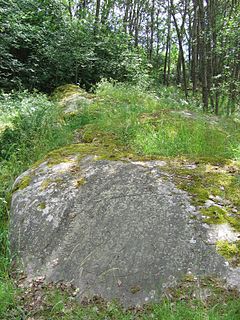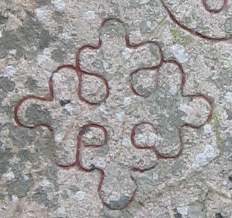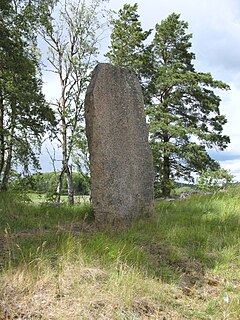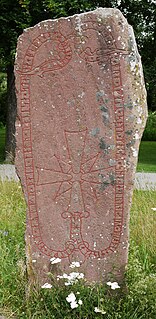
At Broby bro in Uppland, Sweden there are six runestones. U 139, U 140 and U 151 still stand by the road, but U 135, U 136 and U 137 have been moved a distance away from the road.

The Hargs bro runic inscriptions, or U 309, U 310 and U 311, are 11th century Younger Futhark inscriptions in Old Norse on bedrock in Skånela Parish, Uppland, Sweden.

The runestones known as U 101 is located in Sollentuna, and U 143 and U 147 are located in Täby; all three are in Uppland, Sweden. They are all in the style Pr4 and thus dated to the period 1060-1100 during which they were carved in connection with the construction of a road from Hagby to Ed at Edsviken. They belong to a group of c. 20 runestones called the Jarlabanke Runestones that are connected to the local chieftain Jarlabanke and his clan. Together with the Broby bro Runestones and the Hargs bro runic inscriptions these particular runestones, however, centre on the female matriarch of the clan called Estrid, who was the grandmother of Jarlabanke.

The Jarlabanke Runestones is the name of about 20 runestones written in Old Norse with the Younger Futhark rune script in the 11th century, in Uppland, Sweden.

Uppland Runic Inscription 77 is the Rundata catalog number for a Viking Age memorial runestone that is located at Råsta, which is in Sundbyberg Municipality, Stockholm County, Sweden, which is in the historic province of Uppland.
The Ingvar Runestones is the name of around 26 Varangian Runestones that were raised in commemoration of those who died in the Swedish Viking expedition to the Caspian Sea of Ingvar the Far-Travelled.

The Orkesta Runestones are a set of 11th-century runestones engraved in Old Norse with the Younger Futhark alphabet that are located at the church of Orkesta, northeast of Stockholm in Sweden.

The Lingsberg Runestones are two 11th-century runestones, listed as U 240 and U 241 in the Rundata catalog, and one fragment, U 242, that are engraved in Old Norse using the younger futhark. They are at the Lingsberg farm about 2 kilometres (1.2 mi) east of Vallentuna, which is about 24 kilometres (15 mi) north of the center of Stockholm, Stockholm County, Sweden, which was part of the former province of Uppland.
The Greece runestones are about 30 runestones containing information related to voyages made by Norsemen to the Byzantine Empire. They were made during the Viking Age until about 1100 and were engraved in the Old Norse language with Scandinavian runes. All the stones have been found in modern-day Sweden, the majority in Uppland and Södermanland. Most were inscribed in memory of members of the Varangian Guard who never returned home, but a few inscriptions mention men who returned with wealth, and a boulder in Ed was engraved on the orders of a former officer of the Guard.

The Risbyle Runestones are two runestones found near the western shore of Lake Vallentunasjön in Uppland, Sweden, dating from the Viking Age.
The England runestones are a group of about 30 runestones in Northern Europe which refer to Viking Age voyages to England. They constitute one of the largest groups of runestones that mention voyages to other countries, and they are comparable in number only to the approximately 30 Greece Runestones and the 26 Ingvar Runestones, of which the latter refer to a Viking expedition near the Caspian Sea. They were engraved in Old Norse with the Younger Futhark.

The Varangian Runestones are runestones in Scandinavia that mention voyages to the East or the Eastern route, or to more specific eastern locations such as Garðaríki.
The Viking runestones are runestones that mention Scandinavians who participated in Viking expeditions. This article treats the runestone that refer to people who took part in voyages abroad, in western Europe, and stones that mention men who were Viking warriors and/or died while travelling in the West. However, it is likely that all of them do not mention men who took part in pillaging. The inscriptions were all engraved in Old Norse with the Younger Futhark. The runestones are unevenly distributed in Scandinavia: Denmark has 250 runestones, Norway has 50 while Iceland has none. Sweden have as many as between 1,700 and 2,500 depending on definition. The Swedish district of Uppland has the highest concentration with as many as 1,196 inscriptions in stone, whereas Södermanland is second with 391.
The Baltic area runestones are Varangian runestones in memory of men who took part in peaceful or warlike expeditions across the Baltic Sea, where Finland and the Baltic states are presently located.

The Uppland Runic Inscription 328 stands on a hill in a paddock at the farm Stora Lundby, which is about four kilometers west of Lindholmen, Stockholm County, Sweden, in the historic province of Uppland. The runestone is one of several runestones that have permitted scholars to trace family relations among some powerful Viking clans in Sweden during the 11th century.

The Gällsta Runestones from the 11th century commemorate four generations of the same family in Viking Age Sweden. There are three runestones and a raised stone which is only inscribed with a cross. The runestones are located at the northern outskirts of Stockholm, just northwest of the lake Vallentunasjön, around which is found the world's greatest concentration of runestones. All the Gällsta Runestones are attributed to Öpir, the most productive of all the old runemasters.

Uppland Runic Inscription 80 or U 80 is the Rundata catalog listing for a Viking Age memorial runic inscription that is located in Sundby, which is in Solna Municipality, Stockholm County, Sweden, and in the historic province of Uppland.

Östergötland Runic Inscription 224 or Ög 224 is the Rundata catalog number for a Viking Age memorial runestone that is located in Stratomta, 9 kilometers (5.6 mi) east of Linköping, Östergötland, Sweden. The runestone has an inscription on two sides with an image of a ship on the south side.

Södermanland Runic Inscription 178 or Sö 178 is the Rundata catalog number for a Viking Age memorial runestone which is located at Gripsholm Castle, Södermanland County, Sweden, which is in the historic province of Södermanland.

The Uppland Runic Inscription 258 is a Viking Age runestone engraved in Old Norse with the Younger Futhark runic alphabet. It is in granite and located at Fresta Church in Upplands Väsby Municipality.



















